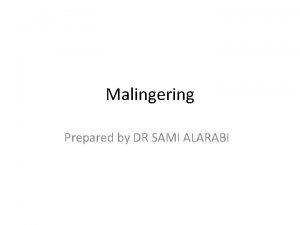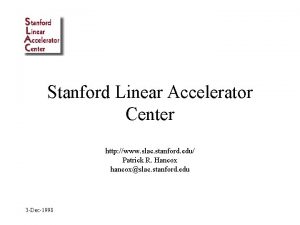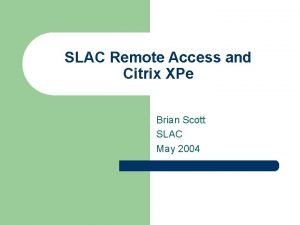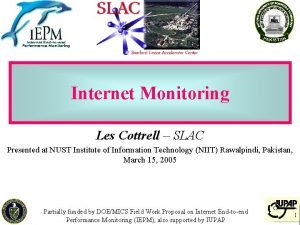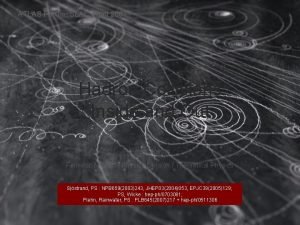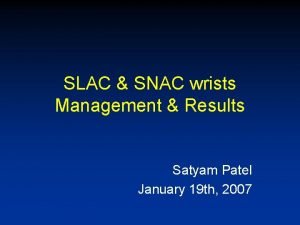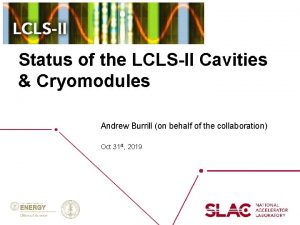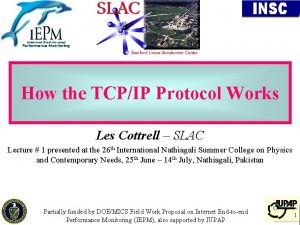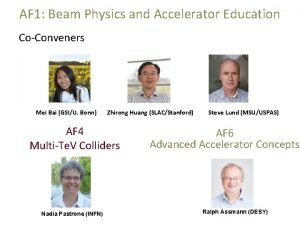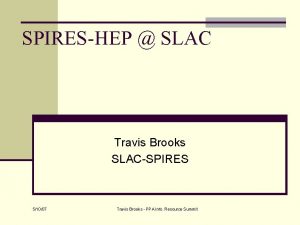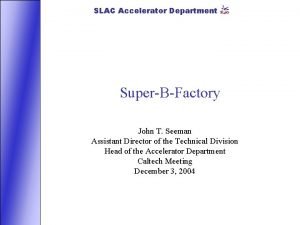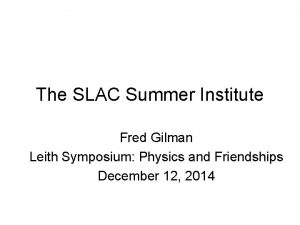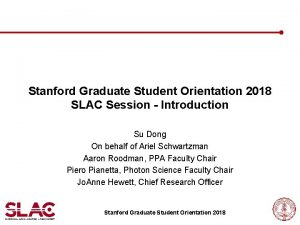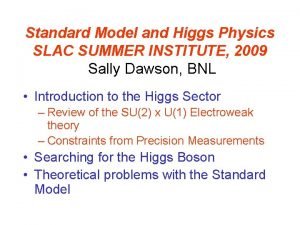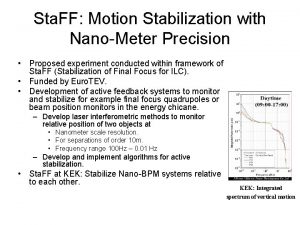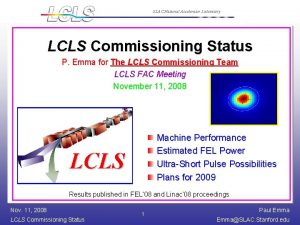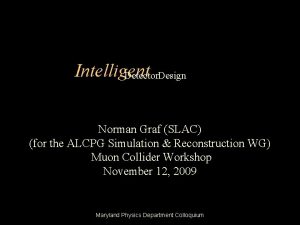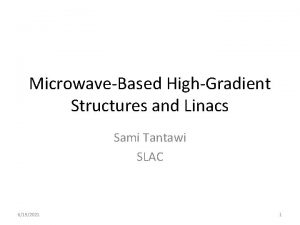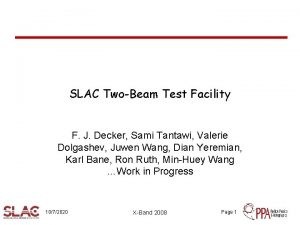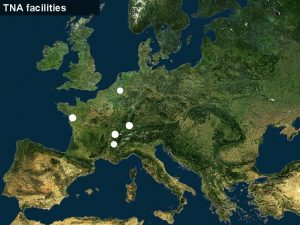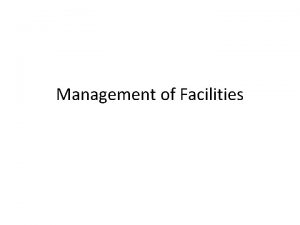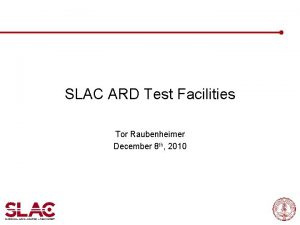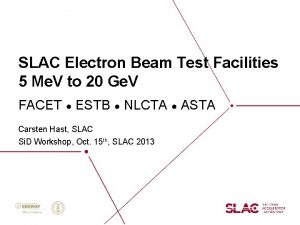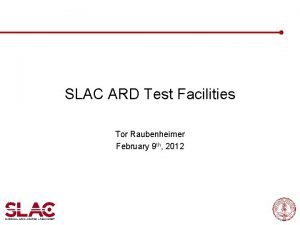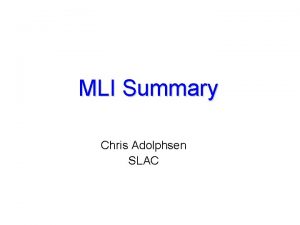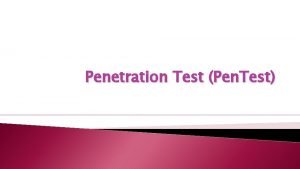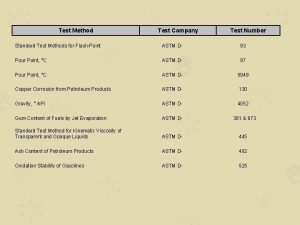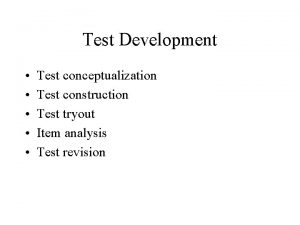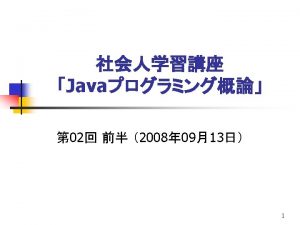Test Facilities Sami Tantawi SLAC Summary of SLAC

















- Slides: 17

Test Facilities Sami Tantawi SLAC

Summary of SLAC Facilities • NLCTA (3 RF stations, one Injector, one Radiation shielding) • Klystron Test Lab (4 RF stations, 4 modulators, 2 shielding enclosures) – Two 240 ns pulse compressor, 300 MW peak, powered by two X-band 50 MW klystrons – One 400 ns/200 ns, variable pulse length pulse compressor, 300 MW/500 MW peak, powered by 2 X-band 50 MW klystrons – 65 Me. V injector with a ~0. 3 n. C charge/bunch – Shielding enclosure suitable for up to 1 Ge. V RF Stations – ASTA: • Stations 6 and 8, two 50 MW klystrons that can be combined and 63 ns/132 ns/264 ns-up to 1. 5 us pulse compressor that can produce up to 550 MW at the smallest pulse length and 100 MW at the longest pulse length. • Shielding enclosure • Two experimental outputs ( can run two experiments at the same time) • Second generation RF complements • Cost effective testing due to versatility and new design of a gate valve ( original idea by Alexi Gudiev) – Station 4, 50 MW klystron: • Dedicated for testing standing wave accelerator structure • Has a stand alone shielding enclosure – Station 2, 50 MW klystron • Dedicated for pulsed heating testing • No sheilding Modulators – Station 1, ~500 k. V, ~200 A modulator – Station 13, ~500 k. V, ~200 A modulator – Station 3, 500 k. V, ~xxx A modulator Radiation Shielding – A shielding enclosure suitable for up to 100 Me. V (ASTA Bunker) – A shielding enclosure suitable for up to 5 Me. V ( station 4)

Pulsed Heating Experiment • • • TE 013 -like mode axi s | E | Station 2 at the klystron test lab, a dedicated 50 MW Klystron station for material testing Retrofitted with a closed cycle cryo-cooler to be able to perform tests from room temperature to 4. 2 K Will continue operation with cryogenic system until fall or until the new pulsed heating system with a camera is ready material sample r= 0. 98” | H | Q 0 = ~44, 000 (Cu, room temp. ) Cavity

Standing-wave Accelerator Structure Testing • A dedicated station with one 50 MW klystron • A shielding enclosure built specially for testing short accelerator structure • Very productive due to international participation( SLAC, KEK and frascatti structure testing program. ) Dr. Yasuo Higashi and Richard Talley assembling Three-C-SW-A 5. 65 -T 4. 6 -Cu. KEK-#2 July 8, 2008 The structures are housed inside an a dedicated lead inside box suitable for up to 5 Me. V SLAC Annual Program Review Page 4

ASTA RF system • Designed for economical testing of TW, SW accelerator structures, and waveguides. • Versatile structure for future applications • Will be retrofitted with an electron gun to test gradients within a year • Wil find other applications and may be demanded for other applications ( may be not related to high gradient work) Gate Valves Variable iris Variable Delay line length through variable mode converter From Two 50 MW Klystrons July 8, 2008 Two experimental stations inside the enclosure, one with compressed pulse and the other without the benefit of the SLAC Annual Program Review pulse compressor Page 5

ASTA (Continued) The uncompressed arm has a variable phase shifter and a gate valve The ASTA pulse compressor with variable delay-lines( Miller cup)

ASTA Pulse Compressor Bent overmoded Waveguide

ASTA Two feeds for the two experimental stations inside the ASTA bunker The ASTA pulse compressor with variable iris

ASTA Status and Future • One klystron need to be replaced ( no vacuum inside the tube!) • Will be replaced with a klystron from the NLCTA 2 pack system • Manufacturing RF components so that we can operate with one klystron if needed on the future • Replaced input iris for the sled system with a water cooled one • In the process of adding an automatic sled system tuning to enhance performance.

ASTA committee on ASTA’s future delivered a report and recommendation to the SLAC management • • Consequently, the committee recommends that a second TWT be purchased to enable independent operation of the x-band Test Stands, and that a production LLRF system be installed alongside the existing specialized LLRF system to enable use of the rf capabilities by a more general user community. The specialized system should remain in place to support experiments calling for more advanced rf pulse control. Adoption of the x-band LLRF system designed for LCLS should be considered. The program calls for installing an electron gun and an energy spectrometer in the near future. The committee recommended that this should be done with a thermionic gun and the present spectrometer, without the use of a photogun Hence the committee recommends that we do not use the LLNL laser at ASTA, but instead purchase a commercially available laser system that meets the needs of all of the programs that will be using ASTA. The LLNL’s immediate need for testing the proposed X-band gun, designed by Vlieks, et. al. , can be satisfied more efficiently at NLCTA

Future developments of the ASTA facility At the moment the ASTA facility is not suitable for a multipurpose user facility. To this end, several developments need to take place to take advance of the facility and optimize its use. The first step towards that goal has been taken by assigning the responsibility for its operation to the ARD Test Facilities Department. The developments that are needed include: 1. Installation of safety equipments for the modulators to allow 24/7 operation 2. Designing and installing a general purpose RF system ( hardware and software) with a fixable and user friendly interface. This is needed for both X-band S-band systems. The need for the S-band system is greater, simply the system does not exist. The xband system is almost adequate for the HG program but certainly need to be upgraded for any other programs. 3. Upgrade the facility’s PPS system to allow for the installation of a laser and a modulator for thermionic gun 4. Installation of thermionic gun for the HG program 5. Upgrading room 152 and installing a laser system for future research activities.

NLCTA – Layout • 3 x RF stations * – 2 x pulse compressors (240 ns - 300 MW max), driven each by 2 x 50 MW X-band klystrons – 1 x pulse compressors (400 ns – 300 MW /200 ns – 500 MW variable), driven by 2 x 50 MW X-band klystrons. • In the accelerator housing: – 2 x 2. 5 m slots for structures * * Shielding Enclosure: suitable up to 1 Ge. V For operation: – Can run 24/7 using automated controls 1 x Injector: 65 Me. V, ~0. 3 n. C / bunch (Gain = 3. 1) 3/3/2009 HG workshop, Mar. 09 Page 12

The Two-Pack/Dual-Moded SLED-II at NLCTA • Will have one klystron now instead of two • Will be used at the beginning of the summer to test the life performance of XL-4 klystrons • Will then be used to test an active pulse compression system built by IAP • Hardware is being built to allow operation with one klystron or two for the future operations

TE 02 TE 01 TE 02 For NLC/GLC, Use Dual Moded Delay Line to Reduce Delay Line Length in Half TE 01

NLCTA Plans in 2010 • Only Stn 1 available until Echo experiment finished, which may be this summer (at least Phase I). • Typically run ~ 500 hours a month per station (e. g. TD 18 ran 1300 hours in ~ 3 month period). • Currently running XL 4 -fat lip. Depending on structure and station availability, will run T 18_CERN (maybe short run just to qualify it), T 24 and TD 24. • This Summer, will relocate Stn 1 structure test area (prep for eventual X-band gun operation in 2011) – will include spectrometer. • Other possible structure tests that could use Stn 1, 2 and perhaps 3 (former Two Pack): X-band gun (rf only), T 18_SLAC_2 with recirculation and 2 CM (2 coaxial mode) cavity. C. Adolphsen

Ultra-Power RF Components Te 10 to TE 01 Mode converter Overmoded 3 d. B hybrid TE 01 over moded Bend Phase Shifters

Vacuum RF Components TE 01 mode Pump-out TE 01 Gate Valve Should contact James Simpson directly to ask for drawings
